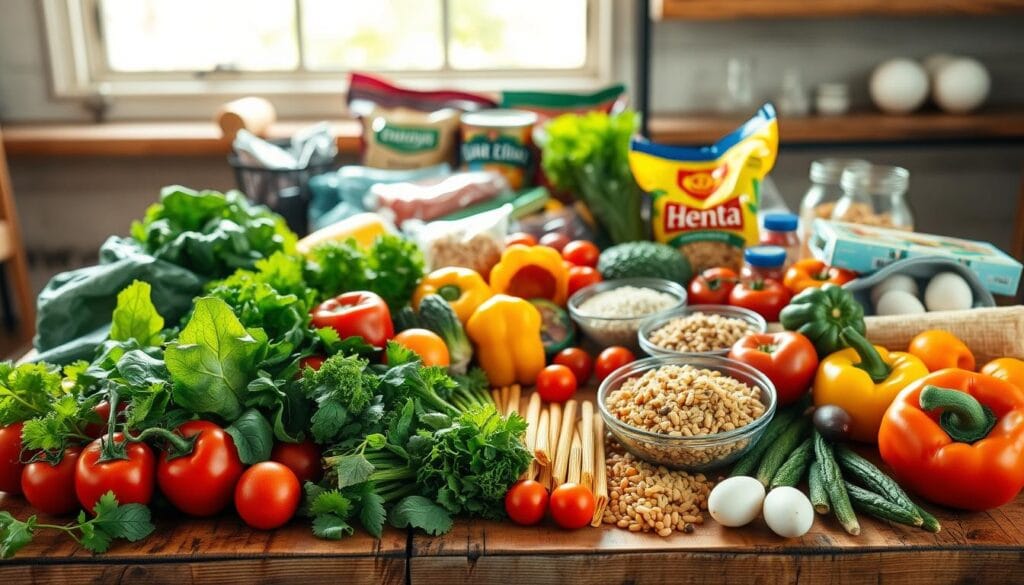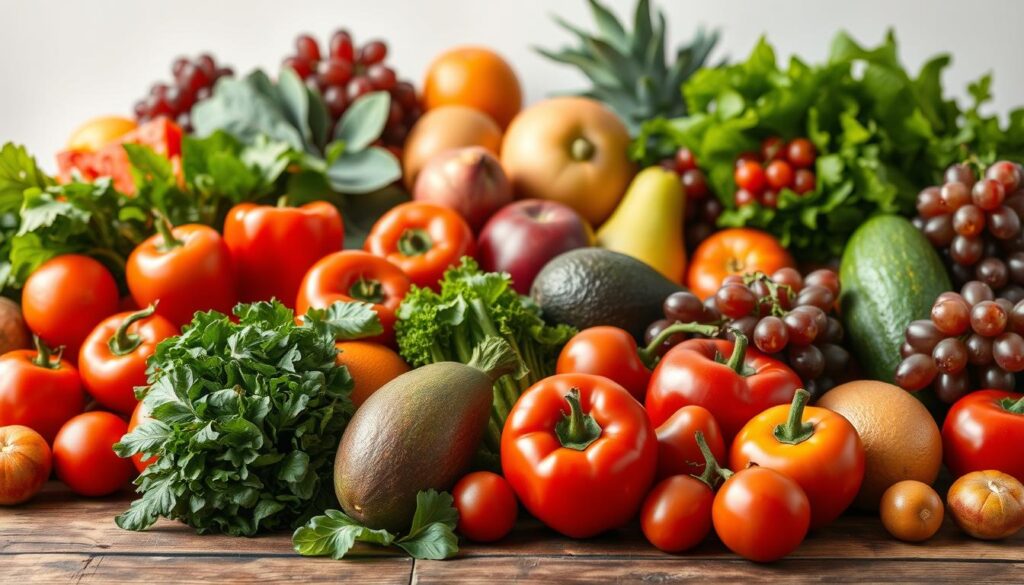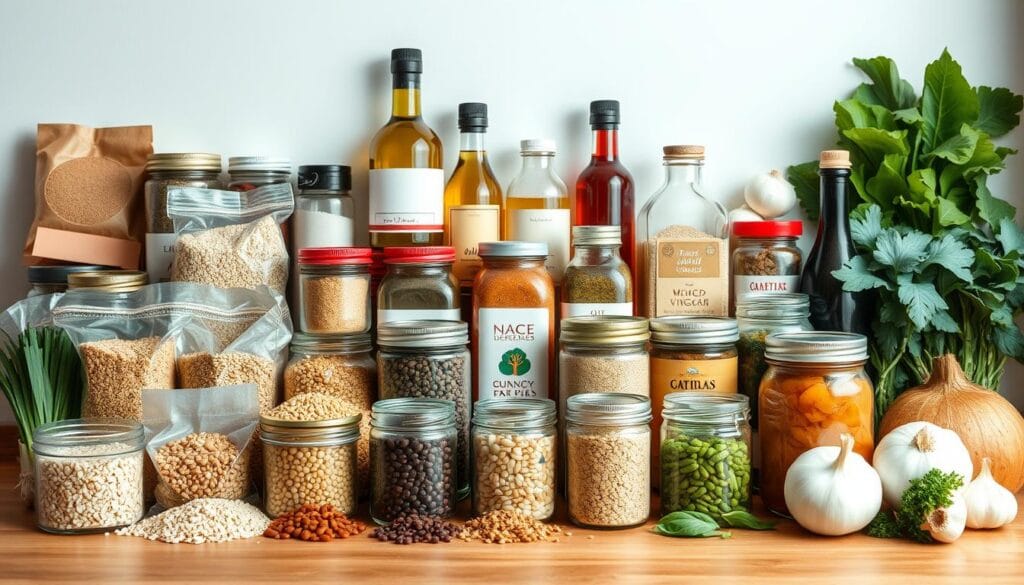Healthy Grocery List for Clean Eating Grocery shopping can be a daunting task, especially when…
As an Amazon Associate I earn from qualifying purchases.
Build a Budget-Friendly Healthy Grocery List

Build a Budget-Friendly Healthy Grocery list. Create a cheap, clean-eating grocery list that fits your budget.
Eating nutritious food doesn’t have to be expensive. Planning meals around what’s on sale can save up to 30% on your weekly food bill.
Creating a budget-friendly grocery list is key to affordable meal planning and smart shopping. By choosing pantry staples and seasonal produce, you can enjoy clean eating without spending too much.
I’ve learned that with some planning, healthy meals can be affordable. In this article, we’ll show you how to make a grocery list that supports your health goals and fits your budget.
Healthy Grocery List: 50+ Affordable Foods
Key Takeaways
- Plan your meals around weekly sales to save money.
- Focus on pantry staples and seasonal produce for affordable nutrition.
- Smart shopping strategies can significantly reduce your grocery bill.
- Clean eating doesn’t have to be expensive with the right approach.
- Building a budget-friendly grocery list is the first step to affordable healthy eating.
The Challenge of Eating Healthy on a Budget
Many think healthy eating costs a lot. They believe it means spending on fancy or organic foods. But, budget clean eating is possible with smart choices.
Common Misconceptions About Healthy Food Costs
People often think healthy food is pricey. Yet, many affordable choices exist. Buying in bulk and meal planning can cut costs a lot.
The Real Cost of Unhealthy Eating
Unhealthy eating can lead to big medical bills. These costs can add up quickly. Let’s compare:
| Food Choice | Short-term Cost | Long-term Cost |
|---|---|---|
| Fast Food | $5-$10 per meal | Potential medical bills: $1,000+ |
| Home-cooked Meal | $3-$5 per serving | Lower risk of diet-related illnesses |
Choosing budget clean eating can save money and improve health over time.
Planning: The Foundation of Budget Clean Eating
Meal planning is key to budget clean eating. It helps me save money and cut down on waste. By planning meals ahead, I make a cheap healthy grocery list that’s good for my health and wallet.
Meal Planning Basics
To begin meal planning, I think about what I want to eat and my health goals. I figure out how many meals I need to plan and what I already have at home. This way, I don’t buy things I already have and reduce waste.
Creating a Weekly Menu
When making a weekly menu, I pick recipes that use similar ingredients. This makes shopping and cooking easier. I also choose seasonal produce to get fresh, affordable food.
Inventory Check Before Shopping
Before I shop, I check what I already have at home. This is important to avoid buying things twice and to use up all my ingredients. It helps me stay on track with my cheap healthy grocery list and keep my budget in check.
Seasonal Shopping Strategies
Understanding seasonal produce cycles is key to eating clean on a budget. Knowing what’s in season helps you plan meals with the freshest, most affordable ingredients.
Understanding Seasonal Produce Cycles
Seasonal produce cycles mean certain fruits and veggies are at their best during specific times. This changes based on where you live and the weather. For example, berries are at their peak in summer, while carrots and beets are easier to find in fall and winter.
Seasonal Produce Calendar for the US
A seasonal produce calendar is a great tool for grocery planning. It shows which fruits and veggies are in season all year. For instance, apples are available from September to May, making them a great choice for most of the year.
How Seasonality Affects Pricing
When produce is in season, it’s more common and cheaper. This is the perfect time to buy your favorite fruits and veggies. It lets you enjoy budget clean eating without sacrificing quality or freshness.
Protein Sources That Won’t Break the Bank
Having a pantry full of affordable protein sources is key to a healthy diet. Protein helps build and repair tissues in the body. It’s a must-have for a cheap healthy grocery list.
Plant-Based Protein Options
Plant-based proteins are good for your health and your wallet. They are affordable and versatile. Here are some of the best options:
Beans and Legumes
Beans and legumes are a staple in many cuisines. They’re full of protein, fiber, and vitamins. You can find them dried or canned, making them easy to add to meals. Buying in bulk from stores like Amazon is a great way to save.
Tofu and Tempeh
Tofu and tempeh are great for protein in many dishes. They’re cheap, especially when bought in bulk. Keep an eye out for sales at your local store or check online for deals.
Budget-Friendly Animal Proteins
There are also affordable animal protein sources to consider.
Eggs and Dairy
Eggs are a cheap and protein-rich food. Dairy like milk, yogurt, and cheese are also good sources. Look for store-brand options to save money.
Affordable Cuts of Meat
Some meat cuts are more affordable than others. Choose tougher cuts that get tender with slow cooking, like chuck roast or pork shoulder. These cuts are cheaper and full of flavor.
Adding these protein sources to your diet helps keep meals healthy and affordable. Mixing and matching these options lets you make tasty, nutritious meals without spending too much.
Whole Grains: Affordable Staples for Your Pantry
Whole grains are key to a healthy diet, offering many benefits without costing much. They make your meals both affordable and nutritious.
Best Bulk Grain Purchases
Buying grains in bulk saves money. Grains like brown rice, quinoa, and whole wheat flour are cheap in large amounts. They’re also great in many recipes.
Comparing Costs: Processed vs. Whole Grains
Many think whole grains cost more than processed ones. But, they’re actually more affordable when you look at nutritional value and cost per serving. As Consumer Reports points out, “whole grains can lower heart disease, diabetes, and cancer risks.”
Storage Solutions for Extended Shelf Life
Keeping grains fresh requires proper storage. Use airtight containers and keep them in a cool, dry spot. As America’s Test Kitchen advises, “grains can stay fresh for up to 6 months with the right storage.”
Fruits and Vegetables: Maximizing Nutrition While Minimizing Cost
Fruits and vegetables are key to a healthy diet but don’t have to cost a lot. To save money, it’s smart to choose wisely when buying produce.
Fresh vs. Frozen vs. Canned
Choosing between fresh, frozen, or canned produce depends on nutrition and cost. Frozen items are often as nutritious as fresh and cheaper, especially for items not in season. Canned goods are also affordable, but pick low-sodium options.

Prioritizing the “Clean Fifteen” and “Dirty Dozen”
Knowing which fruits and vegetables have more pesticides helps you shop better. The “Dirty Dozen” list shows items with high pesticide levels. The “Clean Fifteen” are safer. Buy organic for the “Dirty Dozen” and conventional for the “Clean Fifteen” to save money and stay healthy.
Reducing Waste with Proper Storage
Storing fruits and vegetables right can cut down on waste. For instance, berries last longer in a sealed container with paper towels. Knowing how to store different produce can save you money and help the environment.
| Produce | Storage Tip | Extended Freshness |
|---|---|---|
| Berries | Store in sealed container lined with paper towels | Up to 5 extra days |
| Citrus Fruits | Keep at room temperature or refrigerate | Up to 2 weeks |
| Leafy Greens | Store in breathable bags in the crisper drawer | Up to 7 extra days |
By using these tips, you can enjoy a wide range of fruits and vegetables without spending too much. This way, you can eat healthy on a budget.
Smart Shopping Venues: Where to Find the Best Deals
Smart shopping means knowing where to find great deals on healthy food. I’ve looked into different places for budget-friendly eating. Each spot has its own benefits.
Discount Grocery Stores
Stores like Aldi and Lidl have low prices on basics like whole grains and frozen veggies. Shopping here lets me buy healthy foods without spending too much.
Farmers Markets and CSAs
Farmers markets and CSAs give us fresh, local produce. They support local farmers and offer good prices on seasonal foods.
Ethnic Markets and Bulk Stores
Ethnic markets have cheap prices on special grains and spices. Bulk stores like Costco offer deals on nuts and whole grains. These places help me find new foods and save money.
Online Options and Subscription Services
Online stores and services like Thrive Market and Boxed make buying healthy food easy and cheap. They have sales and promotions that help cut costs.
Money-Saving Shopping Tactics
Using a few simple shopping tactics can greatly reduce your grocery bills. By changing your shopping habits, you can save money on healthy foods. This makes your grocery list more affordable.
Loyalty Programs and Rewards
Store loyalty programs are a great way to save. Many stores offer loyalty cards with discounts and rewards. For example, joining a loyalty program can give you special sales and offers tailored to your shopping.
Couponing Strategies
Couponing can be simple and effective. Look for digital coupons and weekly sales to plan your shopping. Stores now offer digital coupons through their apps, making it easy to save without paper clutter.
Unit Price Comparison
When shopping, always compare unit prices. This helps you find the best deals, especially between brands and sizes. Just check the price per ounce or pound on the label.
Bulk Buying Wisely
Buying in bulk can save money, but do it wisely. Think about your storage and the product’s shelf life. Non-perishable items like grains and canned goods are best for bulk buying.
| Product | Bulk Price | Unit Price |
|---|---|---|
| Whole Wheat Pasta | $15 (20 lbs) | $0.75/lb |
| Quinoa | $20 (25 lbs) | $0.80/lb |
| Canned Black Beans | $10 (12 cans) | $0.83/can |
By using these shopping tactics, you can buy healthy groceries without spending too much. It’s all about being informed, planning, and making smart choices.
Essential Pantry Staples for Your Cheap Healthy Grocery List
A well-stocked pantry is key to eating healthy on a budget. By focusing on essential pantry staples, you can make many healthy meals without spending a lot. I’ll show you the must-have items for your budget-friendly clean eating grocery list.
Budget-Friendly Spices and Seasonings
Spices and seasonings add flavor to your meals without extra cost or salt. Here are some essentials:
Must-Have Basic Spices
- Cumin: Great for adding depth to Mexican and Indian dishes.
- Turmeric: Known for its anti-inflammatory properties and vibrant color.
- Black Pepper: A staple that enhances the flavor of any dish.
- Garlic Powder: Convenient and adds a rich flavor.
- Paprika: Adds a smoky flavor to dishes.
Affordable Spice Blends
Pre-mixed spice blends save you money and time. Consider:
- Italian Seasoning: Perfect for pasta sauces and roasted vegetables.
- Chili Powder: Essential for Mexican dishes.
- Curry Powder: Great for Indian-inspired meals.
Healthy Oils and Vinegars
Oils and vinegars are vital for cooking and dressing salads. Some budget-friendly options include:
- Olive Oil: Ideal for salad dressings and low-heat cooking.
- Coconut Oil: Great for high-heat cooking and baking.
- Balsamic Vinegar: Adds a rich flavor to salads and marinades.
- Apple Cider Vinegar: Useful for dressings and digestive health.
Canned and Jarred Goods Worth Stocking
Canned and jarred goods are affordable and last long. Consider stocking:
| Product | Usage |
|---|---|
| Canned Black Beans | Salads, soups, and Mexican dishes. |
| Canned Tomatoes | Pasta sauces, soups, and stews. |
| Artichoke Hearts | Salads and Mediterranean dishes. |
Baking Essentials for Homemade Savings
Baking your own goods saves money and ensures they’re healthy. Essential baking staples include:
- Whole Wheat Flour: For healthier baked goods.
- Baking Powder and Baking Soda: Leavening agents.
- Vanilla Extract: Adds flavor to baked goods.

Sample Weekly Grocery Lists for Different Budgets
Eating healthy doesn’t have to break the bank. Let’s look at sample grocery lists for budgets of $50, $75, and $100. These lists show how to spend your money wisely and still eat well.
$50 Weekly Grocery List
On a tight budget, stick to basics like whole grains, beans, and fresh veggies. Here’s a list to get you started:
- Whole grains (brown rice, oats, quinoa) – $10
- Canned goods (beans, tomatoes) – $5
- Fresh vegetables (seasonal) – $10
- Fruits (apples, bananas) – $5
- Protein sources (eggs, canned tuna) – $10
- Healthy snacks (nuts, dried fruits) – $10
$75 Weekly Grocery List
With a bit more money, you can mix things up a bit. Here’s what to consider:
| Category | Items | Cost |
|---|---|---|
| Proteins | Chicken breast, salmon fillets, tofu | $25 |
| Dairy/Eggs | Milk, Greek yogurt, eggs | $15 |
| Fruits/Vegetables | Mixed berries, spinach, bell peppers | $20 |
| Grains | Whole wheat bread, quinoa, brown rice | $15 |
$100 Weekly Grocery List
With more money, you can try new foods. Here’s a list to explore:
- Organic produce (fruits, vegetables) – $30
- Lean proteins (chicken, fish, beef) – $25
- Whole grains and snacks – $20
- Dairy and eggs – $15
- Healthy fats (nuts, avocados) – $10
Adjusting for Dietary Restrictions
Need to make changes for dietary needs? Swap out items that don’t fit your diet. For gluten-free, use gluten-free products. For vegan, choose plant-based options.
By using these lists and making adjustments for your diet, you can eat healthy without overspending.
Meal Prep: Stretching Your Grocery Dollar Further
Effective meal prep can stretch your grocery dollar. Planning and preparing meals ahead saves time and money. It also helps you stick to your budget clean eating goals.
Batch Cooking Basics
Batch cooking means making lots of one ingredient or meal at once. It’s great for things like rice, grains, and legumes. Cooking in bulk saves time and keeps healthy ingredients ready.
Freezer-Friendly Meals
Freezer-friendly meals save money and cut down on waste. Make soups, stews, or casseroles to freeze for later. Just thaw and reheat when you want to eat them.
Repurposing Leftovers Creatively
Make tomorrow’s lunch from last night’s dinner by getting creative with leftovers. Use leftover veggies in a soup or stir-fry. Or turn last night’s roast chicken into a chicken salad.
Time-Saving Kitchen Tools Worth the Investment
Getting the right kitchen tools makes meal prep easy. Think about a slow cooker or Instant Pot for quick meal prep. Check out Amazon for tools that save time and effort.
Conclusion: Sustainable Healthy Eating on a Budget
Creating a cheap healthy grocery list is the first step to eating well without spending a lot. By planning meals and shopping for what’s in season, you can eat healthy without breaking the bank. Preparing meals ahead of time also helps.
As we’ve seen, planning meals, smart shopping, and meal prep are key to affordable healthy eating. By making these habits part of your daily routine, you can enjoy a balanced diet while keeping costs down.
Creating a cheap healthy grocery list is more than saving money. It’s about adopting a sustainable way to eat. By choosing wisely and reducing food waste, you can enjoy a healthy diet and help the planet.
FAQ
What are some budget-friendly protein sources for a healthy grocery list?
Affordable protein sources include beans, legumes, tofu, tempeh, eggs, and dairy. Certain cuts of meat are also good options. You can find these at Amazon or local discount stores.
How can I save money on whole grains for my pantry?
Buying whole grains in bulk saves money. Compare prices of processed vs. whole grains. Proper storage extends grain shelf life.
What’s the best way to shop for fruits and vegetables on a budget?
Shop for seasonal produce for cheaper prices. Frozen or canned options are nutritious and less expensive. Focus on the “Clean Fifteen” and avoid the “Dirty Dozen” to save.
Are there any smart shopping venues for healthy groceries?
Yes, try discount stores, farmers markets, CSAs, ethnic markets, and bulk stores. Online options and subscription services are also cost-effective.
How can I save money on pantry staples like spices and oils?
Look for affordable spices and seasonings, and buy in bulk. Healthy oils and vinegars are cheaper in bulk or on sale. Find them on Amazon or at local stores.
Can you provide examples of weekly grocery lists for different budgets?
Yes, there are sample lists for , , and 0 budgets. Adjust them based on dietary needs and preferences.
How can meal prep help stretch my grocery dollar further?
Meal prep like batch cooking and freezer meals saves money. Repurpose leftovers to reduce waste. Time-saving tools make prep more efficient.
What are some tips for creating a cheap healthy grocery list?
Plan meals, shop seasonally, and buy in bulk for a budget-friendly list. Save by shopping at discount stores and using loyalty programs.
How can I adjust my grocery list for dietary restrictions?
For dietary needs, look for alternative proteins and gluten-free options. Consult a healthcare professional or dietitian for personalized advice.
Amazon and the Amazon logo are trademarks of Amazon.com, Inc or it's affiliates.
Related Posts
- Healthy Grocery List for Clean Eating
- Homemade Healthy Granola Recipe
Homemade Healthy Granola Recipe The Ultimate Healthy Granola Delight In the pursuit of a wholesome…
- Making Healthy Eating Affordable
Making Healthy Eating Affordable Tips for Meal Planning, Grocery Shopping, and Cooking at Home When…


